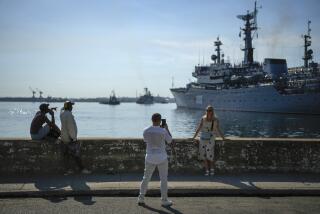Complaints From Cuba to the U.S. Foreshadowed Airplanes’ Downing
- Share via
HAVANA — Less than six weeks before Cuban jet fighters shot down two civilian airplanes last Saturday, an event occurred that the Cuban government viewed as the culmination of an aggressive and dangerous campaign by exile groups invading its airspace and territorial waters.
Two small planes flew over Havana, dropping anti-Communist leaflets. “I was shocked that they let them in,” Havana economist Luis Rene Fernandez said. “Then, when I heard them [the pilots] on the radio bragging about it, I got mad.”
For the fourth time in 20 months, the Cubans sent the United States a diplomatic note about the incursions--two violations in January alone--and asked Americans to control the flights, which originated in Florida. Half a dozen other flights and boating incidents had already been reported, several involving the same planes, all piloted by members of Brothers to the Rescue, the exile group that flew the two Cessna aircraft shot down a week ago, according to the Cuban Foreign Relations Ministry.
*
A record of U.S. replies to the Cuban complaints covers three single-spaced, typed pages, according to non-Cuban diplomatic sources. The only result of that communication, according to the Cubans, was one four-month license suspension in the United States for a pilot who clipped a Cuban ship’s mast.
“They were getting more audacious,” said Carlos Fernandez de Cosio, director of the U.S.-Canada Department of the Foreign Relations Ministry. “Sooner or later, there was going to be an incident with these people, who felt more and more emboldened. It could have been an incident more grave than the one last Saturday and cost more human lives.”
Today, as the U.S. Coast Guard prepares to accompany members of the exile group who plan to drop a wreath in the ocean in memory of the four fliers killed last week, Cubans say they hope Americans have begun to take their warnings about incursions seriously.
“This could become a historic day, when the U.S. authorities finally prevent these people from entering Cuban waters,” Ricardo Alarcon, president of the National Assembly, said here in an interview with a small group of foreign journalists Friday. “If anything were to happen in that area, everyone would realize that the U.S. is responsible.”
The Cubans say they became particularly alarmed when the provocative flights, which had begun sporadically more than a mile from Cuban shores, were becoming more frequent, and the target now appeared to be the capital. Six months before the leaflets were dropped, an exile plane accompanying a flotilla that had entered Cuban waters buzzed Havana, flying dangerously low, Cuban officials said.
Last Saturday, said Fernandez de Cosio, the planes that were shot down were flying near an air base in a restricted zone where no civilian craft are permitted.
*
And Alarcon pulled from his briefcase a sheaf of papers with U.S. State Department seals that appeared to be diplomatic communications advising Cuba of exiles’ plans for incursions into their airspace and territorial waters.
Included was a note dated Oct. 18, 1995, that warned of exiles’ plans to fly near the Cuban coast to transmit radio signals that would interfere with Cuban communications, Alarcon said. There are no indications that this plan was carried out.
Cuban officials had considered restricting all civilian flights into Varadero Airport near Havana, as well as the international flight path over the Bay of Pigs, where Cuban exiles attempted to invade the island in 1961.
“We alerted the U.S. government and nothing happened,” said Fernandez de Cosio. “For us, it was a signal that nothing was going to happen.”
In the end, the Cubans decided that it was unreasonable to restrict air travel in this way to resolve a problem they believed the United States should resolve.
In Washington on Friday, Clinton administration officials expressed confidence that the Saturday memorial service will be peaceful. They said they had had several discussions with Cuban government officials who assured them “they wouldn’t mess around or cause problems if the flotilla and planes involved in the memorial didn’t provocatively enter Cuban space.”
Chief Washington correspondent Jack Nelson contributed to this report.
(BEGIN TEXT OF INFOBOX / INFOGRAPHIC)
Air Space Violations
Cuban diplomats say they have formally advised the United States about eight incursions into their air space from U.S. planes in the past 20 months
Date of incident
May 15, 1994
Nature of incident
Five small planes entered Cuban air space off the coast of the Varadero Beach resort and flew along the coast at distances of 1.5 to 5.5 miles, exiting west of Havanna
*
Date of incident
May 17, 1994
Nature of incident
Two small planes followed the same course as the previous five
*
Date of incident
May 25, 1995
Nature of incident
Five planes followed the same course
*
Date of incident
May 29, 1994
Nature of incident
Five planes floowed the same course.
*
Date of incident
April 4, 1995
Nature of incident
One small plane flew for five miles along the coast east of Havanna at distances of five to 10 miles
*
Date of incident
July 13, 1995
Nature of incident
Three small planes accompanying a flotilla that had invaded Cuban waters buzzed Havana
*
Date of incident
Jan. 9 and 13
Nature of incident
Two planes flew over Havana, dropping anti-communist leaflets
Source: Cuban Foreign Ministry
More to Read
Sign up for Essential California
The most important California stories and recommendations in your inbox every morning.
You may occasionally receive promotional content from the Los Angeles Times.










